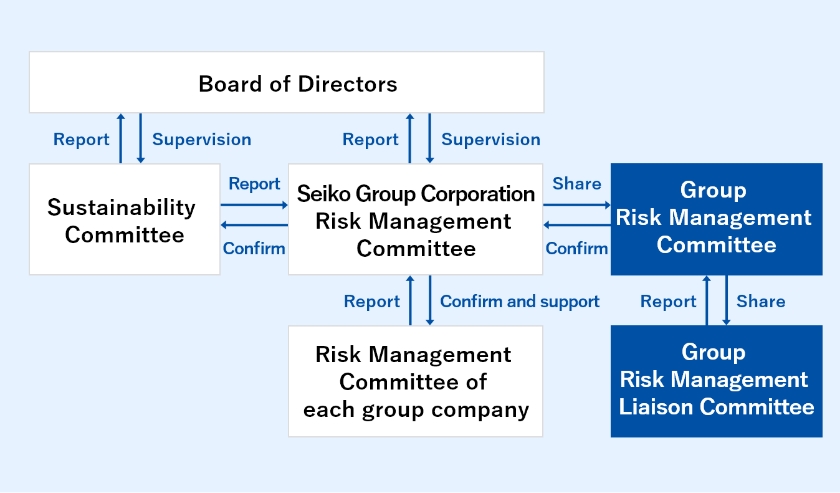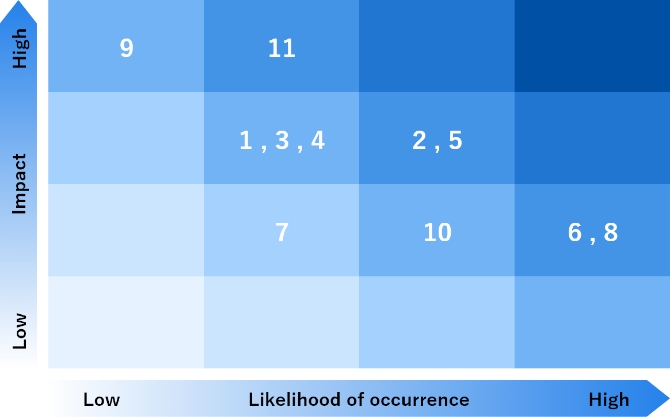To promptly and accurately address various business risks in its operations, Seiko Group identifies “Group Significant Risks” and is working to establish and strengthen its risk management framework.
Group Risk Management Structure
In order to perform centralized management of risks that could greatly influence the Group’s business, the Seiko Group is engaged in the development and strengthening of the risk management structure for the entire Group as well as responses to risks that must be addressed in a cross-organizational manner, led by the Risk Management Committee, with the president of the Company as chairperson. In addition, each operating company independently promotes risk management, while the Company’s Risk Management Committee supports the risk management at each company through collecting risk information and managing the status of responses to the risks. Furthermore, for the aim of smooth promotion of the group risk management in close cooperation and coordination among the Group, the Group Risk Management Committee, made up of the presidents of each operating company, has been established to verify and share information on the risks facing the Group.
The Company has also established the Crisis Management Manual in preparation for when crises occur, and in normal times, has set out a system capable of responding to crises, such as prompt collection of the necessary information.
In addition, for more detailed analysis of climaterelated risks, the Sustainability Committee conducts scenario analysis to identify, assess, and resolve particularly impactful climate change risks for Group companies, and is implementing measures to address these risks with each Group company.
Group Risk Management Structure

Business Risks
Risks that may seriously affect the operating results and/or financial position of the Group are outlined below. The Group considers brand-impairment risks and risks that affect the safety and health of employees and others to be critical risks. Both are mediumterm risks, apart from the risks that have a significant impact on the business results in short term.
- Economic trends
- High dependence on procurement from specific supplier
- Market environment of the DS Business
- Country risks on manufacturing bases overseas
- Dependence on sales to major customers
- Shortage and increase in price of resources
- Quality issues and production liability
- Intellectual property rights
- Currency exchange rate fluctuations
- Interest rate fluctuations
- Market price fluctuations
- Environmental issues
- Information securities
- Natural disasters and influences of infectious diseases
- Compliance risks
Information Security
Given the increasing threat of cyberattacks such as targeted email attacks and malware due to changes in the ICT usage environment, the Group is working on strengthening ongoing measures and improving employee awareness about information security by coordinating control across Group companies.
In addition, in the environment for utilizing information systems, we aim to provide a safe and stable environment by consolidating into data centers equipped with information security and disaster countermeasures, and also strive to improve server efficiency and redundancy through virtualization.
Please refer to our securities report for more details.
Initiatives to Address Significant Risks
The Group defines risks that could cause tremendous loss to the management of each Group company as Significant Risks. The Risk Management Committee of each Group company selects the Significant Risks each fiscal year and addresses them leaded by the departments responsible for the risks. In addition, Significant Risks that must be addressed in a cross-organizational manner are defined as Group Significant Risks, and the Company takes a central role in responding to such risks. The Company’s Risk Management Committee and the Group Risk Management Committee monitor and share information on responses to Significant Risks and Group Significant Risks. The Group Risk Management Liaison Committee comprising risk management personnel from each Group company supports the promotion of measures against the Significant Risks of each company through inter-Group collaboration and cooperation.
Risk map of Group Significant Risks

Group Significant Risks in FY2023
| Category | Risk details |
|---|---|
| Brand-impairment risks | 1.Compliance risk (including conduct risk) |
| 2.IT problems (such as cyberattacks) and operational risks due to significant IT infrastructure issues | |
| 3. Significant legal violations, quality issues, etc. in the supply chain | |
| 4.Delays in and increased costs of decarbonization initiatives | |
| 5.Insufficient response to customer diversity, indirect human rights risks for the Group’s B2B products | |
| Business and financial risks | 6.Rising component and material costs, including energy costs |
| 7.Impact on business activities due to worsening the U.S.-China relations | |
| 8.Impact on business activities due to conflicts including the Taiwan issue (including the situation in Russia and Ukraine) |
|
| 9.Dependence on specific suppliers | |
| 10.Difficulties in securing human resources (development and recruitment) | |
| 11.Delays in innovating the business model |


